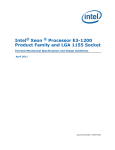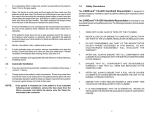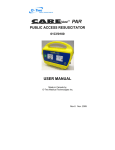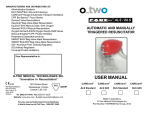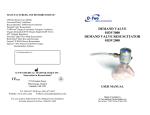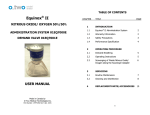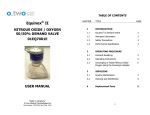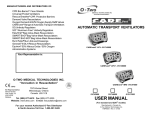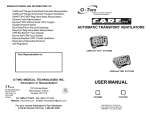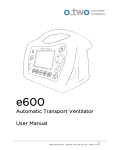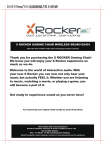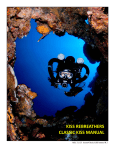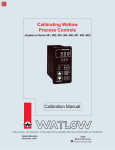Download CAREvent CPAP Manual Rev 5 Booklet June 11 - O
Transcript
TM ® CAREvent Handheld CPAP System 01CV0200 USER MANUAL Made in Canada by O-Two Medical Technologies Inc. Part Number 15PL2172 – Rev 5. June 2011 Table of Contents Chapter 1. Indications for Use Contraindications Warnings Terms and Definitions General Description Principles of Operation Control Adjustment Technical Data Warranty Symbols and Definitions 1 1 1 3 4 4 5 5 7 7 PREPARATION FOR USE 2.1 2.2 2.3 2.4 Component List Connection of Hoses Pre-use Functional Check Patient Circuit Selection 3. OPERATING INSTRUCTIONS 4. AFTER USE CLEANING AND TESTING 4.1 4.2 5. Page INTRODUCTION 1.1 1.2 1.3 1.4 1.5 1.6 1.7 1.8 1.9 1.10 2. Title Dismantling and Cleaning After Use and Monthly Checking 7 8 9 9 10 10 12 MAINTENANCE SCHEDULE 5.1 Annual Preventative Maintenance Inspection 12 6. TROUBLE SHOOTING CHART 13 7. CAREvent® HANDHELD CPAP ACCESSORIES 13 1. INTRODUCTION 1.1 Indications for Use The CAREvent® Handheld CPAP System is intended to provide CPAP to spontaneously breathing patients in the hospital and prehospital (EMS) environments. The device is suitable for use in: • Pre-hospital transport applications emergency rescue vehicles • Hospital ICU transport applications including emergency, surgery, post-Anesthesia / recovery • Air transport via helicopter or fixed wing 1.2 including accident scene, Contraindications The following conditions contraindicate the use of the CAREvent® Handheld CPAP System: • Patients undergoing procedures with flammable anesthetic gases • Patients undergoing hyperbaric treatment 1.3 Warnings The CAREvent® Handheld CPAP System is intended for use by suitably trained and qualified personnel. The following precautions should always be observed: 1. READ THIS MANUAL PRIOR TO ATTEMPTING TO USE THE DEVICE. INCORRECT OPERATION OF THE DEVICE CAN BE HAZARDOUS. 2. WHEN THE UNIT IS IN USE, DO NOT SMOKE OR USE NEAR OPEN FLAME EITHER DURING USE OR WHEN CHANGING THE CYLINDER. 3. WHEN NOT IN USE, ALWAYS TURN OFF THE GAS SUPPLY. 4. NEVER ALLOW OIL OR GREASE TO COME INTO CONTACT WITH ANY PART OF THE CYLINDER, REGULATOR OR DEVICE. 1 5. DO NOT DISASSEMBLE ANY PART OF THE VDEVICE EXCEPT WHERE DESCRIBED IN THIS MANUAL AS ANY UNAUTHORIZED DISASSEMBLY WILL INVALIDATE THE WARRANTY. 6. AFTER USE, ALWAYS ENSURE THAT ALL COMPONENTS ARE CLEANED IN ACCORDANCE WITH THE INSTRUCTIONS PROVIDED IN THIS MANUAL. (SEE SECTION 4) 7. ALWAYS USE THE CHECK LIST TO ENSURE THAT ALL COMPONENTS ARE REASSEMBLED CORRECTLY AND READY FOR USE. 8. IT IS RECOMMENDED THAT A MEANS OF VENTILATING THE PATIENT BE AVAILABLE IN CASE OF RESPIRATORY FAILURE. 9. DURING USE, THE PATIENT SHOULD NOT BE LEFT UNATTENDED. 10. ONLY PATIENT CIRCUITS SUPPLIED BY O-TWO MEDICAL TECHNOLOGIES INC. SHOULD BE USED WITH THIS DEVICE, AS THE USE OF OTHER CIRCUITS MAY ADVERSELY AFFECT THE OUTPUT PERFORMANCE OF THE DEVICE. 11. THE USE OF GAS PRESSURE REGULATORS THAT DO NOT MAINTAIN A MINIMUM OUTPUT PRESSURE AND FLOWRATE IN LINE WITH THE REQUIREMENTS OF THE SPECIFICATION MAY CAUSE THE DEVICE TO FAIL RESULTING IN THE PATIENT RECEIVING INCORRECT TREATMENT. 12. DO NOT USE ATMOSPHERE. CAUTION: IN HAZARDOUS OR EXPLOSIVE Federal law restricts this device to sale by or on the order of a physician. In the USA, the CAREvent® Handheld CPAP System is a restricted medical device intended for use by qualified medical personnel under the direction of a physician. During the transport of patients it is recommended that an alternate source of ventilation be available in the event of driving gas supply failure, device malfunction or a change in the patient’s respiratory requirements. 2 1.4 Terms and Definitions Airway Resistance: pressure drop across the airway per unit flow. Baseline Pressure: The pressure at inspiratory phase. CPAP: A positive pressure applied to the lungs during all ventilation phases (Continuous Positive Airway Pressure). The application of CPAP raises the baseline pressure above “O”. Demand Valve: A valve that delivers gas to the patient at a flowrate equivalent to that demanded by the patient’s inspiratory effort. Expiratory Phase: The time period from the end of the inspiratory flow to the end of the expiratory flow. Expiratory Time (Te): Duration of the expiratory phase. Frequency (f): The number of breaths in one minute (also expressed as BPM). Inspiratory Flow: The flow delivered to the patient by the device during the inspiratory phase. Inspiratory Phase: The interval from the start of the inspiratory flow to the start of the expiratory phase. Inspiratory Time (Ti): Duration of the inspiratory phase. Lung Compliance: Volume added per unit pressure increase when gas added to a human or artificial lung. Minute Volume (Vm): The total volume of gas delivered to the patient in one minute. Oxygen Concentration: The oxygen content of the inspired gases expressed as a percentage. Proximal Airway: The airway pressure measured at Pressure of the patient valve. Patient Valve: The valve which directs the flow of gas into the lungs and out of the expiratory port to atmosphere during expiration. Pressure Relief Valve: Valve which limits the maximum lung inflation pressure by venting excess gas to atmosphere. 3 the commencement of the 1.5 General Description CAREvent® Handheld CPAP System is a small, lightweight, handheld Continuous Positive Airway Pressure (CPAP) system designed for use on spontaneously breathing patients who require respiratory support. The patient is allowed to breathe spontaneously through the device with minimal work of breathing while the CAREvent® Handheld CPAP System provides positive pressure throughout the respiratory cycle delivered non-invasively via a face mask. The CAREvent® Handheld CPAP System is pneumatically powered. No electrical power (mains or battery) is required. The CAREvent® Handheld CPAP System has been specifically designed for use by trained Emergency Medical Professionals, Respiratory Therapists, Nurses and Physicians, both in the prehospital and inhospital environments. 1.6 Principles of Operation The CAREvent® Handheld CPAP System is a pneumatic device that provides Continuous Positive Airway Pressure (CPAP). It provides up to 20 cm H2O CPAP at 120 L/min peak flow for the spontaneously breathing patient. d a b c g e f To Patient Circuit Diagram (Fig 1.) 1. With the gas supply turned on, medical oxygen enters the device via the internal regulator (a) and is filtered and reduced to a lower working pressure (35 psi - 240 kPa). 4 2. Gas from the internal regulator is supplied to the demand valve (b). The demand valve will supply gas at a flowrate equivalent to that demanded by the patient up to 120 L/min. 3. The adjustable CPAP control system adjusts the CPAP level to provide the required amount of CPAP pressure Adjustment of the CPAP control will raise the baseline pressure above zero. As the CPAP pressure setting is balanced against the patients’ respiratory condition the control (d) is adjusted until the desired CPAP level is shown on the airway pressure gauge. A safety pressure relief valve (c) is internally located and is preset for 40 cm H2O. 4. Gas from the demand valve is supplied to the patient via the patient circuit (f) to the patient valve with pressure gauge (g) and then via the mask to the patient. The mask is held in place with the supplied head harness. WARNING: 1.7 The CPAP control is calibrated to the dynamics of the OTwo Medical Technologies Inc. disposable patient circuits (P/N: 01CV8006-CS, 01CV8007-CS, 01CV8008CS. Using this circuit will ensure proper operation and the full 0 to 20 cm H2O CPAP range. Using other patient circuits may adversely effect operation of the device. Control Adjustment To adjust the CPAP setting simply rotate the CPAP control (d) located on the top of the device in a clockwise direction to increase the CPAP level and in a counter clockwise direction to decrease the CPAP level. 1.8 Technical Data (All specifications are subject to a tolerance of +/- 10%) INPUT PRESSURE RANGE: 45 - 87 PSI (3.0 - 6.0 Bar) MINIMUM INPUT FLOWRATE REQUIRED: 140 L/min DEMAND BREATHING FLOWRATE: 0 - 120 L/min DEMAND BREATHING TRIGGERING PRESSURE (@ 100 L/min): - 6 cm H20 CPAP RANGE: 0 - 20 cm H20 5 OXYGEN CONCENTRATION: Up to 100 % OPERATING TEMPERATURE: -18oC to + 50oC 0oF to +122oF STORAGE TEMPERATURE: - 40oC to + 60oC - 40oF to + 140oF STORAGE RELATIVE HUMIDITY 15% TO 95% OPERATING RELATIVE HUMIDITY: 5% TO 95% INSPIRATORY RESISTANCE: <-6 cm H2O @60 L/min EXPIRATORY RESISTANCE: 6 cmH2O @ 60 L/min (with no CPAP applied) EMERGENCY PRESSURE RELIEF: 40 cm H2O (39.2 mBar) PRESSURE GAUGE; 0 – 25 cm H2O +/- 4 % of full scale DIMENSIONS (INCHES): 5.5 x 2.5 x 2.9 (approx) (MILLINETERS): 140 x 63 x 73 (approx) WEIGHT (CPAP System only): (Including cylinder, regulator, carrying case): 16 oz./ 0.45 kg (approx) 176 oz. / 5 kg (approx) PATIENT VALVE DEAD SPACE: 8 ML PATIENT VALVE DEAD SPACE (With manometer): 16 ML CYLINDER DURATION: (Aluminum “D” size cylinder Containing 415 Liters of oxygen.): 55 Min ( at a 6 L minute volume and 7.5 cm H2O CPAP pressure) Note: There are several factors that affect the length of time the device will operate from a tank of oxygen. The major factors are: • Volume of oxygen in the tank • Patient's minute volume • CPAP setting 6 1.9 Warranty The CAREvent® Handheld CPAP System is manufactured from the finest quality materials. Each individual part is subject to strict quality control tests to ensure exceptionally high standards. The manufacturer warrants to the purchaser of the CPAP System that its component parts are free from defects in material and workmanship for a period of two years from the date of purchase. The manufacturer will replace and/or repair all parts of the CPAP System at its option for two years from the date of purchase at no cost to the purchaser, upon the notification of the defects, in writing by the purchaser and confirmation of said defect by the manufacturer. All shipping costs shall be borne by the purchaser. The manufacturer shall be liable under this warranty only if the CPAP System and its parts have been used and serviced in the normal manner described in the instruction manual. There are no other expressed or implied warranties. This warranty gives no specific legal rights. 1.10 Symbols and Definitions Gas Input REF Model Number SN Serial Number IPX4 Splash-Proof Manufacturer Manufacture Date 2. PREPARATION FOR USE 2.1 Component List Having unpacked the device from its shipping carton, use the following list to ensure that all components have been received: [1] Operating Manual [2] CAREvent® CPAP unit [3] Supply Hose [4] Single Use Small, Medium and Large Patient Circuits c/w Patient Valve, Airway Pressure Gauge, Facemask and Head Harness 7 Note: If any components are missing from the shipping carton, immediately call the supplier quoting the packing slip number, your original purchase order number and the description of the item which is missing. 2.2 Connection of Hoses The supply hose provided is attached to the input connection on the rear of the ventilator “finger tight” (fig 2). WARNING: Using a wrench or excessive force in tightening the supply hose may damage the seal or the thread of the connection. The patient circuit is attached to the gas outlet on the front of the device by simply pushing the 22mm taper over the outlet (fig 2). Gas supply hose Patient Circuit Attachment of hoses (Fig. 2) 8 2.3 Pre-use Functional Check Along with the contents of the shipping cartons you will require the following items to enable you to undertake the pre-use functional check: [1] Full oxygen cylinder [2] Oxygen regulator with a 50 psi 9/16 DISS outlet. The regulator must be able to output a minimum of 140 L/min at no less than 40.6 PSIG (2.8 Bar). [3] Calibrated test lung set up to simulate a spontaneously breathing patient (such as a Michigan Instruments Dual Adult TTL) With the device connected to the oxygen supply connect a patient circuit to the outlet of the device and attach the test lung to the 15/22 mm connector on the circuit. Turn on the oxygen supply and adjust the CPAP control to raise the baseline pressure to 10 cm H2O. Operate the test lung at a rate of approximately 10 times per minute to simulate the patient’s inspirations. Ensure that the pressure gauge returns to 10 ± 2 cm H2O after each squeeze. Note: After testing, set the CPAP level to zero, turn off the oxygen supply hose and re-package the device ready for immediate use. Always ensure that the cylinder is full. 2.4 Patient Circuit Selection The patient circuit designed for use with CAREvent® CPAP Handheld CPAP System comes in three sizes: Small, Medium and Large (O-Two Medical Technologies part #’s: 01CV8006-CS, 01CV8007-CS, 01CV8008-CS). These patient circuits are intended for single patient use. Cleaning, reprocessing and / or reuse of these circuits are not recommended. This circuit may also be connected to an endotracheal tube or other artificial airway. WARNINGS: Patient circuits other than the O-Two Medical Technologies circuit may alter the CPAP characteristics and / or expiratory flow resistance. They should NOT be used. The patient circuit must be attached to CAREvent® CPAP Handheld CPAP System properly. Incorrect attachment could result in failure to provide adequate oxygen delivery. 9 Notes: The breathing circuit and all of its components are clean and non- sterile. If required a high efficiency respiratory filter/HME may be connected between the patient circuit and the facemask to protect the patient, rescuers and the device from expired air contamination. 3. OPERATING INSTRUCTIONS 1. With the device connected to the oxygen supply connect the appropriately sized CAREvent® Handheld CPAP System circuit with facemask, airway pressure gauge and head harness. 2. Inform the patient of what you will be doing. 3. With the CPAP control fully rotated counter clockwise to turn off the CPAP flow, turn on the oxygen supply, apply the mask to the patient and attach with the head harness ensuring that the mask seals and is comfortable for the patient. 4. Adjust the CPAP control to the desired level as per local protocols. 5. Monitor the pressure gauge to ensure proper delivery of CPAP. 6. Monitor the patient and the device as per local protocols. 7. If using a portable oxygen cylinder, monitor the supply level to ensure there is sufficient gas to power the device. 8. Never leave the patient unattended. 4. AFTER USE CLEANING AND TESTING 4.1 Dismantling and cleaning the CAREvent® Handheld CPAP System and Accessories Routine cleaning of the equipment should be undertaken to maintain the equipment in a clean condition. Reusable patient valve swivel housing can be cleaned using a mild soap solution and disinfected using a legally marketed commercially available disinfectant, suitable for the application. Single use patient valves and masks should be discarded after each patient use and replaced with a new unit. 10 All other components should be wiped clean with a mild soap solution. Under no circumstances should the complete unit be allowed to be soaked or immersed in cleaning solutions. Patient Valve Swivel housing Disassembly of the CAREvent® Handheld CPAP System (fig 3.) Cleaning procedure 1. Ensure that the CAREvent® Handheld CPAP System is disconnected from the gas supply source. 2. Remove the single patient use circuit from the device. 3. Remove the patient valve swivel housing (a) from the body of the resuscitator (b) (fig 3). 4. Wash all components thoroughly in a mild soap solution and disinfect as required. 5. The body of the CAREvent® Handheld CPAP System can be wiped over with a soft cloth and mild soap solution. 6. If there is ingrained contamination a soft bristled brush may be used. 7. Dry all components thoroughly. 11 8. Reassemble unit, attach a new patient circuit and connect to an oxygen supply to check operation in accordance with 2.3 prior to packaging for emergency use. Note: Safely dispose of the single use valve/mask combination in accordance with local protocols. 4.2 After Use and Monthly Checking WARNING: The CAREvent® Handheld CPAP System is designed to provide respiratory support for respiratory impaired patients. Failure to follow the maintenance and inspection routines properly could result in incorrect operation of the device. To ensure proper operation of the CAREvent® Handheld CPAP System regular inspection and checking of the device and accessories for correct function should be undertaken by a responsible member of staff on a routine basis. This check is to ensure that all of the accessories and resuscitator components are present, the oxygen cylinder is full and that the resuscitator is in working order. Regulator working pressure and device limiting pressures should be checked at least every six months, and more frequently in high use applications. Units with test pressures outside of the ranges listed in the product specifications should not be used. The product is not designed for field disassembly or service outside that indicated in this manual. Any malfunctioning units should be returned to the manufacturer or an Authorized Dealer. Unauthorized repairs will nullify the product warranty. Note: Units with test parameters outside of the ranges listed in the product specifications should not be used. Any units not meeting performance criteria should be returned to the Manufacturer or an authorized repair centre. 5. MAINTENANCE SCHEDULE 5.1 Annual Preventative Maintenance Inspection It is recommended that the CAREvent® Handheld CPAP System is returned to a service centre (authorized by the manufacturer to undertake service and repair of this device) for an Annual Preventative Maintenance inspection (more frequently in high use areas). The inspection will incorporate a full diagnostic test of all parameters. When complete, a certificate of compliance will be issued to cover the device for the next service period. 12 This maintenance inspection, providing it is carried out by an authorized service centre, will not affect the product warranty. 6. Note: TROUBLE SHOOTING CHART If any of the remedies do not resolve the problem you are experiencing please contact your nearest Approved Service Centre. Symptom Probable Cause Remedy Device does not operate insufficient gas supply Replace cylinder Insufficient CPAP Pressure Incorrect setting Adjust CPAP level CPAP pressure does not adjust Circuit leak Adjust mask fit or replace circuit Insufficient Demand flow Supply pressure low Check gas supply and replace as required 7. CAREvent® HANDHELD CPAP SYSTEM ACCESSORIES 17MP9039-CPAP-CS NON-REBREATH V/C ASSY FOR CPAP (Case/10) 01CV8006-CS Single patient use CPAP Circuit (Large) c/w facemask, airway pressure gauge and head harness (Case/10) 01CV8007-CS Single patient use CPAP Circuit (Medium) c/w facemask, airway pressure gauge and head harness (Case/10) 01CV8008-CS Single patient use CPAP Circuit (Small) c/w facemask, airway pressure gauge and head harness (Case/10) 01FV4302 6 Foot Nylon Braided Replacement Supply Hose with 9/16" DISS Fittings 01CC8013 CAREvent CPAP softpack carrying case 13 MANUFACTURERS AND DISTRIBUTORS OF: CPR Bio-Barrier® Face Shields Universal Pocket Ventilators Rescue Breather® CPR Protective Barriers Demand Valve Resuscitators Oxygen Demand & BVM Oxygen Supply Refill Valves CAREvent® Range of Automatic Transport Ventilators SQ Unibody Regulators SQB “Aluminum Free” Unibody Regulators Easy Grip® Bag-Valve-Mask Resuscitators SMART BAG® Bag-Valve-Mask Resuscitators SMART BAG MO® Bag-Valve-Mask Resuscitators Burn Relief® Burn Kits and Dressings Genesis® II IDLH Rescue Resuscitators Equinox® 50% Nitrous Oxide / 50% Oxygen Administration Systems Your Representative is: O-TWO MEDICAL TECHNOLOGIES INC. “Innovation in Resuscitation” EU Representative: Marcel Houben Rue Vinâve, 32 4030 LIEGE Belgique 7575 Kimbel Street Mississauga, Ontario Canada L5S 1C8 Tel. (905) 677-9410 Fax (905) 677-2035 Website: www.otwo.com E-mail: [email protected] For your nearest Authorized O-Two Distributor In North America call Toll Free 1-800-387-3405
















